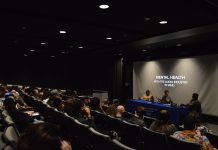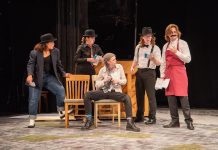
By Megan Washausen
Webster University freshman Jesse Muñoz did not attend the Banned Books Read-Out held Tuesday, Oct. 2 on the Quad with the intention of reading aloud.
After opening remarks were made, Muñoz was the first person to approach the caution tape-covered-podium and read in front of several students spread out on the grass in front of him. Matching black T-shirts classified the students as “With the Banned.”
John Watts, instruction and liaison librarian, planned the event in cooperation with associate professor Robin Assner’s first-year seminar, Censored. The event was a celebration of the 30th anniversary of Banned Books Week.
Spanning from Sept. 30 to Oct. 6, Banned Books Week recognizes the significance of having free and open accessibility to information. The involved faculty and students were hopeful that reading passages of banned or commonly challenged books aloud would spread awareness about the harmful nature of censorship.
“I think that it’s natural to want to protect young people from the realities of the world,” Watts said. “However, it gets dangerous when you try to impart this mindset of censorship to an entire community of people who may or may not share the same beliefs that you do.”
Though there were quite a few members of the Webster library faculty in attendance, the Banned Books Read-Out brought more than just the literary community together. Assner’s students are all art students within the same learning community. Adjunct professor Teresa Sweeney and the students of her first-year seminar, Course that Must Not Be Named: An Investigation of Harry Potter, were also in attendance. Muñoz, an acting major, is in Sweeney’s seminar.
Sweeney delivered a dramatic reading of a passage from the seventh book in the Harry Potter Series, “Harry Potter and the Deathly Hallows.” The series has been challenged and destroyed in book burnings over its depiction of magic and witches.
As an artist, Assner is familiar with censorship. She has dealt with people not wanting to show her work in the past because of its content, which commonly contains nudity.
“Some of my work I wouldn’t necessarily show a 3-or 4-year-old, and it’s not like you are going to see it at a bus stop,” Assner said. “But at a gallery, it is your choice to go in and see it, like it is your choice to read the book or not read the book. It’s your decision.”
Assner believes in order for students to make these decisions, they must first know their options and be made aware by the institutions they attend.
“In schools, I feel it is our duty to open students’ minds and allow them opportunities to talk about these issues,” Assner said. “We think, ‘Oh, the old times and the history,’ but this is happening now. We are having these conversations now on a global scale, and I think it is so relevant, especially for a group of young artists.”
As one of the young artists Assner speaks of, Muñoz — though an opponent of censorship — welcomes the controversy.
“People are always going to try to censor any type of media, but I think it’s important that there is that issue because it causes discussion and causes people to think,” Muñoz said. “I think that’s a huge part of the creation of art. I think this is probably the first time that as a class, we felt like, ‘You know, this is college,’ and we can kind of openly express these ideas without having a filter.”
Teresa Sweeney, instructor of the freshman seminar class Course That Must Not Be Named, reads from book seven of the Harry Potter series, Harry Potter and the Deathly Hallows. This reading comes from Chapter Two: In Memoriam.



